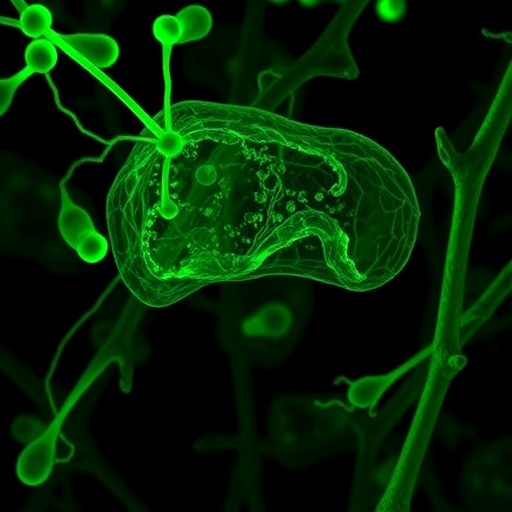In a groundbreaking study published in 2025, researchers have unveiled the potent ability of nelfinavir, an antiretroviral drug traditionally used in HIV therapy, to induce ferroptosis—a unique form of programmed cell death—in hepatocellular carcinoma (HCC) cells. This discovery could pave the way for novel therapeutic strategies to combat liver cancer, a notoriously aggressive and difficult-to-treat malignancy.
Ferroptosis has recently gained immense attention in oncology due to its distinct mechanism compared to apoptosis or necrosis. Characterized by iron-dependent lipid peroxidation, ferroptosis disrupts cellular integrity, leading to cell death. The intricate regulation of this process involves various molecular players, notably the glutathione peroxidase 4 (GPX4) enzyme and the glutathione (GSH) antioxidant system. Their role in guarding cellular membranes against oxidative damage makes them critical to cell survival. Zhang and Wang’s research delves into how nelfinavir manipulates these molecular systems within HCC cells, steering them toward ferroptotic demise.
At the heart of their findings is the drug’s ability to induce endoplasmic reticulum (ER) stress in liver cancer cells. The ER is essential for protein folding and cellular homeostasis, and disturbances here can initiate stress responses that reshape cell fate. Nelfinavir triggers ER stress pathways that downregulate the GPX4/GSH axis, the cellular antioxidant defense mechanism. This downregulation diminishes the cell’s capacity to neutralize lethal lipid peroxides, thereby sensitizing HCC cells to ferroptosis.
Simultaneously, nelfinavir provokes an upregulation of the NRF2/HO-1 axis. NRF2 (nuclear factor erythroid 2-related factor 2) plays a dual role in cancer biology by mediating antioxidant responses and cellular survival, while HO-1 (heme oxygenase-1) is a stress-responsive enzyme that modulates oxidative stress and inflammation. The upregulation of this axis represents a complex cellular response where cancer cells attempt to counteract oxidative damage. However, in the context of nelfinavir treatment, this attempt fails to restore balance, tipping the redox state toward ferroptosis.
The interplay between ER stress and the antioxidant systems reveals a multifaceted approach by which nelfinavir disrupts cellular health in HCC cells. By impairing the GPX4/GSH system, the drug removes a critical barrier against ferroptosis. Concurrently, mitochondrial functions are compromised, as indicated in the study, further exacerbating oxidative stress. Mitochondrial impairment disrupts energy production and elevates reactive oxygen species (ROS), culminating in irrevocable damage and cancer cell death.
These insights hold profound implications for targeted cancer therapy. Nelfinavir’s ability to exploit vulnerabilities in HCC cells by modulating ER stress and oxidative stress pathways highlights a promising paradigm. Traditional chemotherapy often struggles with resistance and toxicity, but inducing ferroptosis may overcome these hurdles by engaging a death pathway cancer cells are less adapted to resist.
Moreover, the repurposing of an existing drug like nelfinavir carries clinical advantages. Its established safety profile hastens the transition from bench to bedside, potentially expediting clinical trials and therapeutic adoption. The study also underscores the importance of understanding the microenvironmental and intracellular contexts in liver cancer, which influence responsiveness to ferroptosis-inducing agents.
This research resonates amid a broader scientific trend investigating ferroptosis in various cancers. By delineating molecular underpinnings such as ER stress-mediated GPX4 decline and NRF2/HO-1 activation, scientists can better strategize combination therapies that enhance ferroptosis or circumvent adaptive resistance mechanisms. For instance, pairing nelfinavir with iron modulators or inhibitors of NRF2 signaling might amplify anticancer efficacy.
Future research directions prompted by Zhang and Wang’s findings include exploring the precise signaling cascades linking ER stress to ferroptosis execution. A deeper characterization of mitochondrial dysfunction in this context could also reveal novel therapeutic targets. Additionally, assessing nelfinavir’s impact in vivo and its effects on tumor microenvironment components such as immune cells and stromal cells will be critical.
Given the high mortality rate of hepatocellular carcinoma worldwide, innovations in treatment carry urgent significance. The complexity of HCC’s genetic and metabolic landscape demands multifaceted therapies. Nelfinavir’s action on multiple fronts—ER stress induction, antioxidant pathway disruption, and mitochondrial impairment—positions it as a formidable candidate in combination regimens.
This study highlights an intriguing paradox: cancer cells’ intrinsic stress response mechanisms designed for survival can be hijacked to cause their own destruction. By tipping the oxidative balance and preventing repair, nelfinavir pushes HCC cells into ferroptotic death, bypassing conventional apoptosis resistance often seen in malignancies.
The broader implications extend into drug development and precision medicine. Understanding patient-specific expression profiles of GPX4, NRF2, and HO-1 could guide personalized use of ferroptosis-inducing drugs. Therapeutic windows might be finely tuned to maximize cancer cell vulnerability while sparing normal cells, which may have more robust antioxidant capacity.
In sum, Zhang and Wang’s work charts an exciting frontier in cancer biology and therapeutics, illuminating how a repurposed drug can weaponize ferroptosis through sophisticated molecular orchestration. The interplay of ER stress, antioxidant defenses, and mitochondrial integrity encapsulates the intricate cellular landscape that cancer researchers must navigate to develop next-generation therapies.
As the scientific community advances, this research not only offers hope for liver cancer patients but also enriches our fundamental understanding of cellular death mechanisms. It reaffirms the potential of translational medicine where insights from virology and cell stress biology converge to yield innovative oncological interventions. Nelfinavir’s unexpected role in ferroptosis induction exemplifies the unforeseen treasures science can unveil when diverse disciplines intersect.
Subject of Research: Nelfinavir’s induction of ferroptosis through ER stress and related molecular pathways in hepatocellular carcinoma cells.
Article Title: Nelfinavir triggers ferroptosis by inducing ER stress mediated downregulation of GPX4/GSH system, upregulation of NRF2/HO-1 axis, and mitochondrial impairment in hepatocellular carcinoma cells.
Article References:
Zhang, L., Wang, X. Nelfinavir triggers ferroptosis by inducing ER stress mediated downregulation of GPX4/GSH system, upregulation of NRF2/HO-1 axis, and mitochondrial impairment in hepatocellular carcinoma cells. Cell Death Discov. 11, 444 (2025). https://doi.org/10.1038/s41420-025-02761-w
Image Credits: AI Generated




